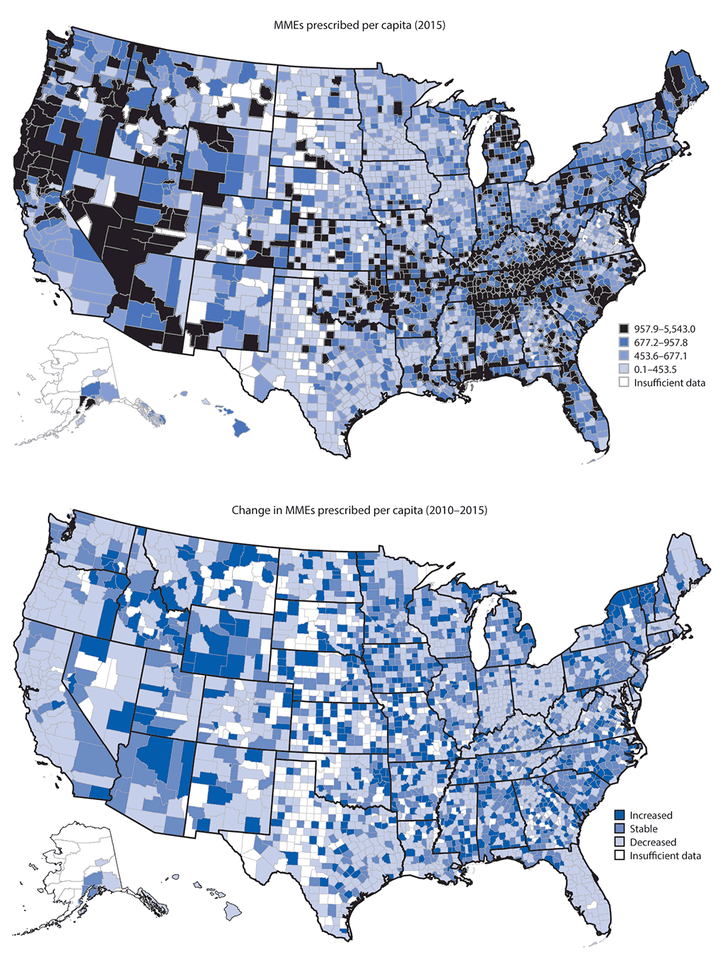Despite the country’s best efforts to curb opioid prescriptions in America, a new analysis suggests Americans still dramatically overuse the medications.
Data published this week by the U.S. Centers for Disease Control and Prevention found that the average amount of opioids prescribed per person in the United States essentially tripled from 1999 to 2015.
Researchers analyzed counties across the country based on the average amount of opioid prescriptions per person in order to reach their results. The opioids were measured in morphine milligram equivalents (MMEs), which accounts for the fact that different dosages or medications vary depending on the person.
Rural areas of the country, in particular, saw higher amounts of MMEs per person than bigger cities. The top 25 percent of the counties have residents that are mostly white, in poor health, and have lower income, according to the results.
But the good news is that efforts to address addiction are working. Despite the overall increase in the medications since 1999, the report did find prescriptions dropped nearly 20 percent between 2010 and 2015. The states where there’s been a greater focus on addiction treatment, like Kentucky and Ohio, saw a decline in both prescriptions and opioid-related deaths in their counties, according to the results.
Here’s a breakdown of some key statistics in the report:
- The amount of opioids prescribed in 2015 were approximately four times higher in the U.S. than in Europe.
- Annual opioid prescribing rates increased from 72.4 prescriptions to 81.2 prescriptions per 100 people from 2006 to 2010. That figure remained stable from 2010 to 2012, then dropped to 70.6 prescriptions per 100 people from 2012 to 2015.
- Larger amounts of opioids were prescribed in micropolitan counties (essentially areas with smaller populations) over the course of the report.
- Counties with a higher prevalence of diagnosed diabetes and arthritis also saw higher prescription opioid rates.

What this all means
The CDC report is a mixed bag in terms of progress. The analysis shows prescriptions are trending in the right direction: downward. That said, there’s a long way to go when it comes to getting a handle on the opioid crisis.
A recent report from STAT News estimates that, based on collected data from universities and public health experts, 500,000 people will die from opioids over the next decade. Another study published last month found that more than half of painkiller prescriptions are distributed to people with mental health issues. These individuals are at an increased risk for abusing prescription opioids, according to research.
There’s also a growing concern about what effects a repeal of the Affordable Care Act might have on the opioid epidemic. Lawmakers and medical organizations have stressed that drastic cuts to the Medicaid program, like the current Senate GOP reform bill proposes, could limit treatment availability for people with opioid addiction. And research shows medical support is vital to reducing opioid use.
The health care bill also could allow states to waive essential health benefits. This would allow insurance companies in those areas to exclude certain benefits from their coverage, like mental health or substance use disorder services.
That move could lead to people having to pay for added coverage for these issues. An analysis conducted by the Center for American Progress suggests that coverage for addiction treatment cost an extra $20,450 per person by the year 2026 under the proposed Senate GOP health care plan.
CDC researchers hope the new analysis provides some insight into what communities should address when it comes to addiction treatment.
“Changes in opioid prescribing can save lives,” the authors wrote in their conclusion. “The findings of this report demonstrate that substantial changes are possible and that more are needed.”
How physicians play a role
According to the report, there needs to better guidelines for physicians prescribing these pills across the board ― and doctors especially need to take them seriously.
This is particularly true when it comes to both chronic pain and acute pain. The CDC warns against prescribing opioids at all when it comes to health issues like arthritis or back injuries. Medical organizations have also long warned that the risk for addiction when taking these medications often supersedes any potential benefits for pain relief.
The CDC also encourages doctors to try other treatment paths for chronic pain not associated with cancer or end-of-life conditions, including drugs like acetaminophen or ibuprofen and lifestyle behaviors like exercise and therapy.